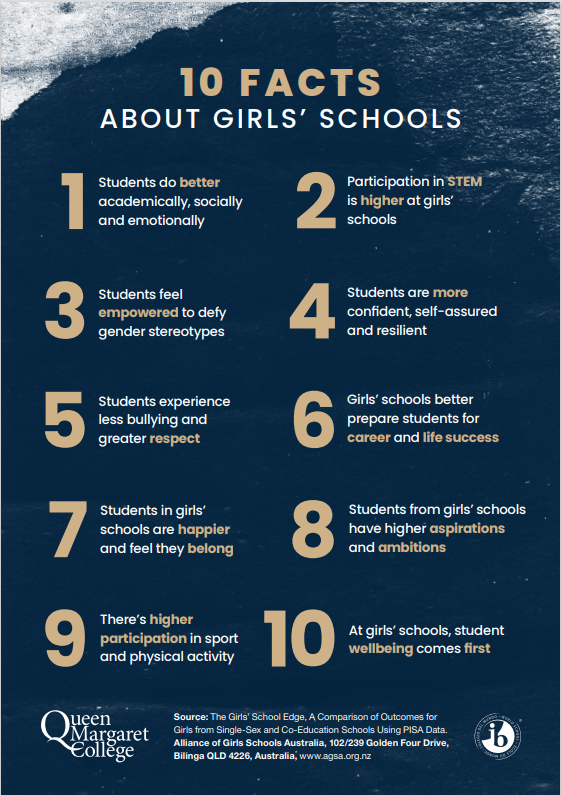Have you ever wondered why we're so dedicated to championing girls education? Here's why.

Research from around the world provides strong evidence that girls-only education leads to higher academic achievement, higher confidence levels, greater participation in STEM, and enhanced career aspirations. In the absence of boys, teaching is tailored to girls’ learning needs and preferences, and activities and academic opportunities are free of gender-stereotyping. Girls have more grit, greater self-esteem and feel empowered to achieve their full potential.
Her academic success: higher confidence and better outcomes
A groundbreaking Australian study, Hands Up For Gender Equality, found that girls educated in single-sex schools are equally as confident as boys educated in single-sex schools. In other words, the frequently reported gender difference in confidence levels between men and women in the workplace simply does not exist for girls educated in girls’ schools. This confidence has been shown to be critical to academic and life success. It also begs the question: Is it mixed-sex environments that contribute to girls’ and women’s lower levels of confidence?
An analysis of the OECD’s Programme for International Student Assessment (PISA) results show that girls from girls’ schools in Australia and New Zealand outperformed girls from co-educational schools on all academic measures of science, mathematics and literacy.
Several Australian studies also demonstrate that girls in single-sex schools are more confident in maths in junior secondary and more likely to take advanced science and maths subjects in senior secondary than girls in co-ed schools.
Her career: no limits to what she can achieve
Enjoyment of science and maths subjects and activities like coding and robotics inspire girls to pursue careers in STEMM (science, technology, engineering, maths and medicine). Graduates of girls’ schools in Australia and New Zealand are significantly more likely to enter male-dominated fields like engineering and construction than girls from co-ed schools.
A study of nearly 6,000 incoming female university students found that graduates of all-girl schools are more likely to show higher levels of science self-confidence, consider themselves critical thinkers, score higher on measures of academic habits of mind, and demonstrate stronger ako habits.
Her wellbeing: comfortable with her body image and being herself
Raising a confident, self-assured daughter who is comfortable with her body image is not an easy task these days. Studies show that girls in co-ed schools have lower self-esteem and feel more pressure to be thin than girls in single-sex schools. Girls in co-ed schools are more likely than girls in single-sex schools to fast, diet and go to other extremes often associated with eating disorders.
In contrast, single-sex schools encourage “improved self-esteem” and “psychological and social wellbeing in adolescent girls”. All-girl classes also help girls through the critical middle school years when they are struggling with social interactions relating to adolescence.
Her safety: there’s less bullying and greater respect
The incidence of bullying for girls in single-sex schools is markedly lower than for girls in co-educational schools across all six of PISA’s measures of bullying — including being made fun of, being the subject of nasty rumours, and being pushed or hit — with a difference of up to 11 percentage points.
Research has found less aggressive behaviours in girls’ schools than in boys’ and co-educational schools,11 while many girls report preferring girls-only science, computing and IT classes where they are not subject to stereotyped beliefs and bullying by boys. Similarly for physical education (PE) classes and sporting activities, international research shows that a large majority of girls strongly prefer all-female PE classes and sports where they are not self-conscious of their body image and what they are wearing. They do not have to take part in competitive mixed-gender activities which reinforce existing stereotypes and undermine girls’ enjoyment of physical exercise which is so important to their long-term physical and mental health.
Her voice: there’s no place for inequality
Sexism and harassment are commonplace across all levels of society and the often-used excuse of “boys will be boys” simply reinforces ingrained and unacceptable stereotypes and sexist beliefs.
An Australian study of five co-educational schools confirmed previous findings that sexual bullying behaviours are commonplace within mixed-sex schools.
Similarly, a report by Britain’s Institute of Physics, Opening Doors, found that sexist language was often dismissed as “harmless banter” in co-ed schools, although many girls did not see it as such and that, “in extreme cases, it verged on bullying”.
Even more concerningly, an inquiry by a committee of the British Parliament found that girls in co-ed high schools are subjected to daily sexual harassment, including unwanted sexual touching and sexting, and are the victims of implicit bias by teachers who steer girls away from ‘hard’ subjects like advanced maths, physics and computer science.
More recently, UK and Australian studies found that students not only experienced gender bias from teachers in STEM related subjects, but in generalised behaviour management, where girls were often used as tools to address boys’ behaviour. Equally disturbing, girls reported not feeling safe at school, due to constant harassment and a failure of teachers to respond appropriately to their complaints.
However, in a girls’ school, girls are intentionally “equipped with the knowledge and skills required to overcome social and cultural gender biases and in doing so actively break the stereotypical norms that define women in society.”
These outcomes have been confirmed by a 2021 scoping review of the past twenty years of research on single-sex education which has found that single-sex schools and classes have the “potential to enable the challenging or disrupting of some gender norms, by both girls and boys” and that there is “promising” evidence that single-sex education is better than co-educational models at “creating conditions for equity”.
Sourced from: Single-sex education for girls - The research - Alliance of Girls’ Schools Australasia (agsa.org.au)

